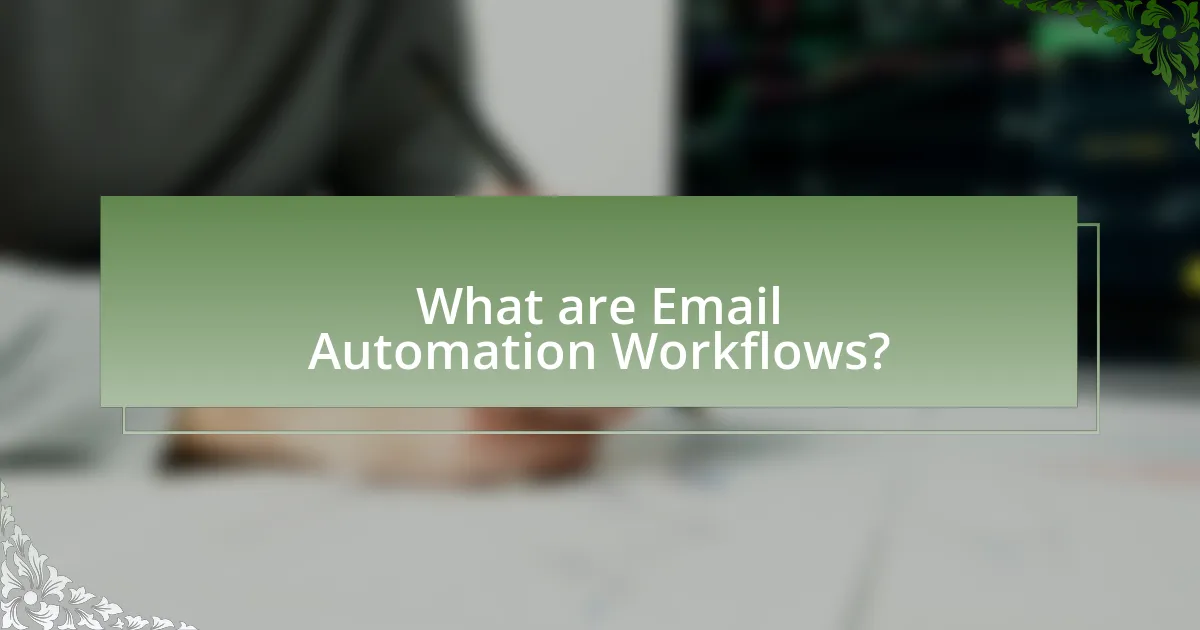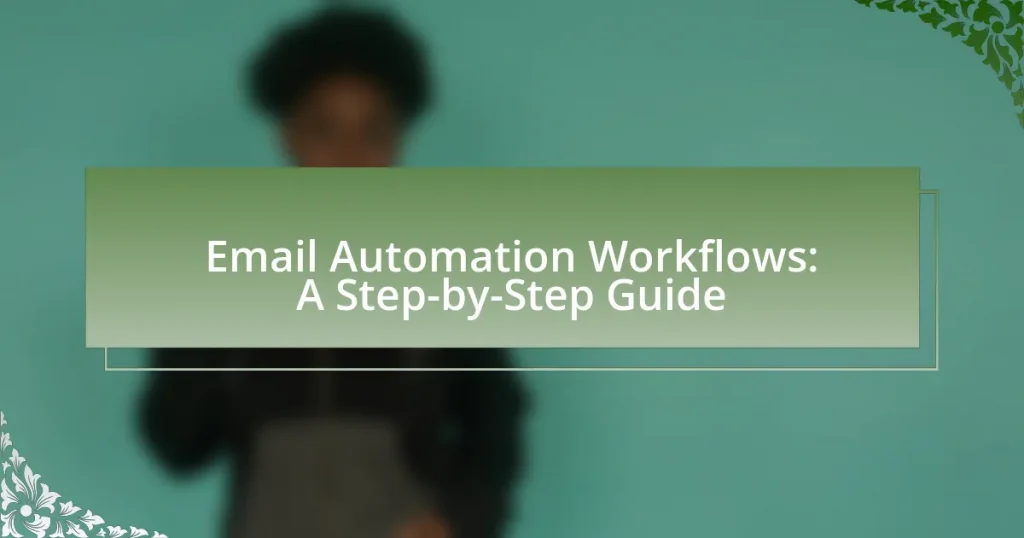Email automation workflows are structured sequences of automated email communications triggered by specific user actions or predefined conditions, designed to enhance customer interaction and improve conversion rates. This article provides a comprehensive overview of how these workflows function, detailing key components such as triggers, actions, conditions, and segmentation. It also explores the benefits of using email automation, including increased efficiency and customer engagement, while outlining best practices for creating and managing effective workflows. Additionally, the article addresses common mistakes to avoid, troubleshooting tips, and resources for further learning, ensuring marketers can optimize their email strategies for better performance.

What are Email Automation Workflows?
Email automation workflows are structured sequences of automated email communications triggered by specific user actions or predefined conditions. These workflows enable businesses to send targeted messages to recipients based on their behavior, preferences, or engagement levels, enhancing customer interaction and improving conversion rates. For instance, a common workflow might automatically send a welcome email to a new subscriber immediately after they sign up, followed by a series of educational emails over the next few weeks. This approach not only saves time but also ensures that relevant content reaches the audience at the right moment, ultimately leading to higher engagement and retention rates.
How do Email Automation Workflows function?
Email automation workflows function by automating the process of sending emails based on predefined triggers and conditions. These workflows utilize software to segment audiences, schedule messages, and personalize content, ensuring that recipients receive relevant communications at the right time. For example, when a user subscribes to a newsletter, the workflow can automatically send a welcome email, followed by a series of targeted messages based on user behavior, such as clicks or purchases. This method increases engagement and conversion rates, as studies show that personalized emails can lead to a 29% higher open rate and a 41% higher click-through rate compared to non-personalized emails.
What are the key components of Email Automation Workflows?
The key components of Email Automation Workflows include triggers, actions, conditions, and segmentation. Triggers initiate the workflow based on specific user behaviors, such as signing up for a newsletter or making a purchase. Actions define what happens next, such as sending an email or updating a contact’s information. Conditions allow for decision-making within the workflow, determining the path based on user attributes or behaviors. Segmentation involves categorizing contacts to tailor messages effectively, ensuring that the right audience receives the appropriate content. These components work together to create efficient and personalized email marketing strategies, enhancing user engagement and conversion rates.
How do triggers and actions work within Email Automation Workflows?
Triggers initiate actions within Email Automation Workflows by responding to specific user behaviors or events, such as signing up for a newsletter or clicking a link in an email. When a trigger occurs, it activates a predefined action, which can include sending a welcome email, following up with additional content, or segmenting the user for targeted campaigns. This mechanism allows marketers to automate communication based on real-time interactions, enhancing engagement and improving conversion rates. For instance, according to a study by HubSpot, automated emails can generate 320% more revenue than non-automated emails, demonstrating the effectiveness of using triggers and actions in email marketing strategies.
What are the benefits of using Email Automation Workflows?
Email automation workflows enhance efficiency and engagement in marketing strategies. They allow businesses to send targeted messages based on user behavior, which can lead to higher open and click-through rates. According to a study by the Direct Marketing Association, automated emails have a 119% higher click rate than broadcast emails. Additionally, these workflows save time by automating repetitive tasks, enabling marketers to focus on strategy and creativity. Furthermore, they provide valuable insights through analytics, allowing for continuous optimization of campaigns.
How do Email Automation Workflows improve efficiency?
Email automation workflows improve efficiency by streamlining communication processes and reducing manual tasks. These workflows automatically send targeted emails based on user behavior, preferences, or specific triggers, which minimizes the time spent on repetitive tasks. For instance, a study by HubSpot found that businesses using email automation can increase their productivity by up to 30%, as automated emails can be sent at optimal times without human intervention. This allows teams to focus on strategic initiatives rather than routine communications, ultimately enhancing overall operational efficiency.
What impact do Email Automation Workflows have on customer engagement?
Email automation workflows significantly enhance customer engagement by delivering timely, personalized content that resonates with individual preferences. These workflows enable businesses to automate communication based on customer behavior, such as sending welcome emails, follow-ups, or re-engagement messages, which can lead to higher open and click-through rates. For instance, studies show that personalized emails can increase transaction rates by up to six times compared to non-personalized emails. This targeted approach not only fosters a stronger connection between the brand and the customer but also drives conversions and customer loyalty.

How can you create effective Email Automation Workflows?
To create effective email automation workflows, first define clear objectives for your campaigns, such as increasing engagement or driving sales. Next, segment your audience based on their behaviors and preferences to tailor your messages effectively. Implement triggers that initiate emails based on specific actions, like signing up for a newsletter or abandoning a cart. Additionally, utilize A/B testing to optimize subject lines and content for better performance. According to a study by Mailchimp, segmented campaigns can lead to a 14.31% higher open rate, demonstrating the importance of targeted messaging in automation workflows.
What steps are involved in designing Email Automation Workflows?
Designing Email Automation Workflows involves several key steps: defining objectives, segmenting the audience, mapping the customer journey, creating email content, setting up triggers, testing the workflow, and analyzing performance.
Firstly, defining objectives clarifies the purpose of the automation, such as increasing engagement or driving sales. Secondly, segmenting the audience allows for targeted messaging based on user behavior or demographics. Mapping the customer journey identifies touchpoints where emails can be effectively integrated.
Creating email content involves crafting messages that resonate with the audience and align with the defined objectives. Setting up triggers automates the sending of emails based on specific actions taken by users, such as signing up for a newsletter. Testing the workflow ensures that all elements function correctly and that emails are delivered as intended. Finally, analyzing performance through metrics like open rates and click-through rates provides insights into the effectiveness of the workflow, allowing for ongoing optimization.
These steps are essential for creating effective email automation workflows that drive desired outcomes.
How do you define your goals for Email Automation Workflows?
To define goals for Email Automation Workflows, identify specific outcomes such as increasing engagement rates, improving conversion rates, or enhancing customer retention. These goals should be measurable and aligned with overall marketing objectives. For instance, a goal could be to achieve a 20% increase in open rates within three months, supported by industry benchmarks indicating that personalized emails can boost engagement by up to 29%. This approach ensures that the defined goals are not only clear but also grounded in proven effectiveness.
What tools can assist in building Email Automation Workflows?
Tools that can assist in building Email Automation Workflows include platforms like Mailchimp, HubSpot, ActiveCampaign, and SendinBlue. These tools provide features such as drag-and-drop workflow builders, segmentation, and analytics, enabling users to create targeted email campaigns efficiently. For instance, Mailchimp offers automation templates that simplify the process of setting up workflows based on user behavior, while HubSpot integrates CRM capabilities to enhance personalization. ActiveCampaign is known for its advanced automation features, allowing for complex workflows based on customer interactions. SendinBlue provides a cost-effective solution with robust automation capabilities, making it suitable for businesses of all sizes.
What are common mistakes to avoid when creating Email Automation Workflows?
Common mistakes to avoid when creating Email Automation Workflows include neglecting audience segmentation, failing to personalize content, and not testing workflows before launch. Neglecting audience segmentation can lead to irrelevant messaging, which decreases engagement rates; studies show that segmented campaigns can result in a 760% increase in revenue. Failing to personalize content can make emails feel generic, reducing open rates; personalized emails have been shown to improve click-through rates by 14%. Not testing workflows can result in errors that damage brand reputation; according to a survey by Litmus, 43% of marketers reported sending emails with errors due to lack of testing.
How can poor segmentation affect Email Automation Workflows?
Poor segmentation can significantly hinder the effectiveness of email automation workflows by leading to irrelevant content being sent to recipients. When audiences are not accurately segmented based on their behaviors, preferences, or demographics, the likelihood of engagement decreases, resulting in lower open and click-through rates. For instance, a study by Mailchimp found that segmented campaigns can lead to a 14.31% higher open rate compared to non-segmented campaigns. This indicates that without proper segmentation, businesses miss opportunities to connect with their audience, ultimately affecting conversion rates and customer satisfaction.
What role does testing play in optimizing Email Automation Workflows?
Testing plays a crucial role in optimizing Email Automation Workflows by ensuring that emails are effectively reaching and engaging the target audience. Through A/B testing, marketers can evaluate different subject lines, content formats, and sending times to determine which variations yield the highest open and click-through rates. For instance, a study by Campaign Monitor found that segmented email campaigns can lead to a 760% increase in revenue, highlighting the importance of testing in tailoring messages to specific audience segments. By systematically testing and analyzing results, businesses can refine their strategies, improve user engagement, and ultimately enhance the overall performance of their email automation efforts.

What are the best practices for managing Email Automation Workflows?
The best practices for managing Email Automation Workflows include segmenting your audience, personalizing content, testing and optimizing campaigns, monitoring performance metrics, and ensuring compliance with regulations. Segmenting your audience allows for targeted messaging, which can increase engagement rates; studies show that segmented campaigns can lead to a 760% increase in revenue. Personalization enhances user experience, as personalized emails have been found to generate six times higher transaction rates. Regular testing, such as A/B testing subject lines and content, helps identify what resonates best with your audience. Monitoring key performance indicators, like open rates and click-through rates, enables continuous improvement of your workflows. Lastly, compliance with regulations such as GDPR and CAN-SPAM is crucial to avoid legal issues and maintain customer trust.
How can you monitor the performance of Email Automation Workflows?
To monitor the performance of Email Automation Workflows, utilize key performance indicators (KPIs) such as open rates, click-through rates, conversion rates, and unsubscribe rates. These metrics provide quantifiable insights into how recipients engage with the emails. For instance, a study by Mailchimp indicates that the average open rate for email campaigns across industries is around 21.33%, which can serve as a benchmark for evaluating your workflow’s effectiveness. Additionally, employing A/B testing allows for the comparison of different email versions to determine which performs better, further enhancing the optimization process. Analyzing these metrics regularly enables continuous improvement of email strategies and ensures alignment with marketing goals.
What metrics should you track for Email Automation Workflows?
The key metrics to track for Email Automation Workflows include open rates, click-through rates, conversion rates, bounce rates, and unsubscribe rates. Open rates measure the percentage of recipients who open the email, indicating the effectiveness of subject lines and timing. Click-through rates assess the percentage of recipients who click on links within the email, reflecting engagement levels. Conversion rates track the percentage of recipients who complete a desired action, such as making a purchase, showcasing the workflow’s effectiveness in driving results. Bounce rates indicate the percentage of emails that were not delivered, helping identify issues with email lists. Unsubscribe rates reveal how many recipients opted out, providing insights into content relevance and audience satisfaction. Tracking these metrics allows for data-driven adjustments to optimize email automation strategies.
How can feedback be incorporated to improve Email Automation Workflows?
Feedback can be incorporated to improve Email Automation Workflows by systematically analyzing recipient responses and engagement metrics. By collecting data on open rates, click-through rates, and unsubscribe rates, marketers can identify which elements of their emails resonate with the audience. For instance, A/B testing different subject lines or content formats allows for direct comparison of performance, leading to informed adjustments in future campaigns. Additionally, soliciting direct feedback through surveys or follow-up emails can provide qualitative insights into customer preferences and pain points, enabling further refinement of the workflow. This data-driven approach ensures that email automation strategies are continuously optimized based on real user interactions and preferences.
What troubleshooting tips can enhance Email Automation Workflows?
To enhance Email Automation Workflows, regularly monitor and analyze email performance metrics such as open rates, click-through rates, and bounce rates. This data helps identify issues like low engagement or delivery problems. Additionally, ensure that email lists are regularly cleaned to remove inactive or invalid addresses, which can improve deliverability and engagement. Implement A/B testing for subject lines and content to determine what resonates best with the audience, leading to higher effectiveness. Furthermore, check for technical issues such as broken links or incorrect personalization tags, as these can negatively impact user experience and trust. Regularly updating and optimizing workflows based on these insights can significantly enhance overall performance.
How do you resolve common issues in Email Automation Workflows?
To resolve common issues in Email Automation Workflows, first identify the specific problem, such as deliverability, segmentation errors, or timing issues. For instance, if emails are not reaching recipients, check the sender’s reputation and ensure compliance with anti-spam regulations, as studies show that 21% of emails are marked as spam due to poor sender reputation. Next, review the segmentation criteria to ensure that the right audience is targeted, which can improve engagement rates by up to 50%. Additionally, analyze the timing of email sends; research indicates that sending emails at optimal times can increase open rates significantly. By systematically addressing these areas, common issues can be effectively resolved, leading to improved performance of email automation workflows.
What resources are available for further learning about Email Automation Workflows?
Comprehensive resources for further learning about Email Automation Workflows include online courses, webinars, and industry blogs. Platforms like Coursera and Udemy offer structured courses on email marketing and automation, while HubSpot Academy provides free certifications specifically focused on email marketing strategies. Additionally, blogs from Mailchimp and ActiveCampaign frequently publish articles and guides that delve into best practices and case studies related to email automation. These resources are validated by their widespread use in the industry and the expertise of their authors, ensuring that learners receive accurate and actionable information.




